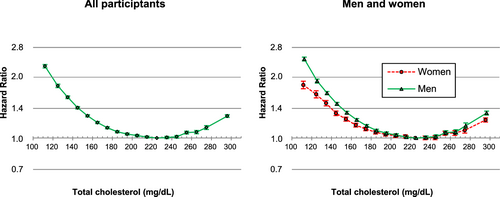 Fairly often I have patients come in worried about their cholesterol levels. Their medical doctor has told them that they are at serious risk of having a heart attack or stroke because their cholesterol levels are too high. I will ask them what their total cholesterol levels are and they will guiltily confess that they are way up to 220 or even 230. I will nod solemnly and carefully suggest that things are probably not as bad as their doctor is saying. Once I explain the real facts about cholesterol, the conversation usually shifts to how can they tell their doctor that they don’t want to take statins for their supposed life-threatening problem. This is not a small concern. We need to have a good relationship with our primary caregivers for the times when we really need them. It is just that the cholesterol scare is simply not one of those times.
Fairly often I have patients come in worried about their cholesterol levels. Their medical doctor has told them that they are at serious risk of having a heart attack or stroke because their cholesterol levels are too high. I will ask them what their total cholesterol levels are and they will guiltily confess that they are way up to 220 or even 230. I will nod solemnly and carefully suggest that things are probably not as bad as their doctor is saying. Once I explain the real facts about cholesterol, the conversation usually shifts to how can they tell their doctor that they don’t want to take statins for their supposed life-threatening problem. This is not a small concern. We need to have a good relationship with our primary caregivers for the times when we really need them. It is just that the cholesterol scare is simply not one of those times.
 So what are the real facts? Well, there has been literally a ton of research on cholesterol over the last 50 years. The understanding of cholesterol has been slowly evolving. Certain things seem to point to cholesterol being a culprit in the formation of atherosclerosis and heart disease. Yes, cholesterol does appear in the plaque that clogs up the arteries. Yes, oxidized damaged cholesterol does get very sticky and tries to cling to damaged areas of the inner lining of arteries (but not in veins – interesting). If you cut somebody open who has just died of a massive coronary and you slice open any artery around the heart, you will find lots of hard soapy/greasy cholesterol in those arteries. It sure looks like the problem is all this cholesterol blocking up the blood vessels.
So what are the real facts? Well, there has been literally a ton of research on cholesterol over the last 50 years. The understanding of cholesterol has been slowly evolving. Certain things seem to point to cholesterol being a culprit in the formation of atherosclerosis and heart disease. Yes, cholesterol does appear in the plaque that clogs up the arteries. Yes, oxidized damaged cholesterol does get very sticky and tries to cling to damaged areas of the inner lining of arteries (but not in veins – interesting). If you cut somebody open who has just died of a massive coronary and you slice open any artery around the heart, you will find lots of hard soapy/greasy cholesterol in those arteries. It sure looks like the problem is all this cholesterol blocking up the blood vessels.
 So what is the problem with this picture? Let us use a simile. You drive down to the delta and notice the waterways are clogged with dead fish and lots of green algae. You know from that special you watched that too many algae robs the water of oxygen the fish need to breathe. You assume that the problem is the algae. On a certain level, you are right, but your remedy to the problem will be to kill off the algae. You go to the city council and convince them to dump tons of copper sulfate into the river upstream to kill off the algae. Sure enough, the algae dies and it looks like you have solved the problem…except that next year, the same problem has come back. What do you do? Do you keep dumping toxic levels of copper sulfate into the river every year? Some of the residents who get their household water from the river are not too happy with this solution. They want to know why they never had this algae and dead fish problem years ago.
So what is the problem with this picture? Let us use a simile. You drive down to the delta and notice the waterways are clogged with dead fish and lots of green algae. You know from that special you watched that too many algae robs the water of oxygen the fish need to breathe. You assume that the problem is the algae. On a certain level, you are right, but your remedy to the problem will be to kill off the algae. You go to the city council and convince them to dump tons of copper sulfate into the river upstream to kill off the algae. Sure enough, the algae dies and it looks like you have solved the problem…except that next year, the same problem has come back. What do you do? Do you keep dumping toxic levels of copper sulfate into the river every year? Some of the residents who get their household water from the river are not too happy with this solution. They want to know why they never had this algae and dead fish problem years ago.
 This is where inquiring minds start asking questions and research gets done. It takes time and money, but the inquiring minds finally figure out that the real problem is the runoff from all the fertilizer and chemicals used in the rice fields each year flowing into the river is triggering the algae blooms and fish die-off. Even this might not have been enough to cause the problem if the normal flow of water were present to flush away the rice field runoff, but somebody decided to drain the majority of the water from the river and ship it to southern California in an aqueduct. So is the cause of dead fish really just too many people living in SoCal? In reality, the answer is complex. There are lots of causal factors. This is the reality of how things work in the body. The body is complex.
This is where inquiring minds start asking questions and research gets done. It takes time and money, but the inquiring minds finally figure out that the real problem is the runoff from all the fertilizer and chemicals used in the rice fields each year flowing into the river is triggering the algae blooms and fish die-off. Even this might not have been enough to cause the problem if the normal flow of water were present to flush away the rice field runoff, but somebody decided to drain the majority of the water from the river and ship it to southern California in an aqueduct. So is the cause of dead fish really just too many people living in SoCal? In reality, the answer is complex. There are lots of causal factors. This is the reality of how things work in the body. The body is complex.
Teasing out the truth is challenging, but the real world tries to show us the way. A massive study done four years ago on the cholesterol story was brought to my attention and prompted me to write this article. This study is so huge that it should punch serious holes in most of the theories currently running around medical circles about how dangerous cholesterol is. This study was done on 12.8 million people who were followed for 13 years looking for any factors that could predict death from any cause. During that time 694,423 of the people died. Their health records were combed over in detail. Here is the chart showing how cholesterol figured into the equation.

Total cholesterol and all-cause mortality by sex and age: a prospective cohort study among 12.8 million adults Sang-Wook Yi, Jee-Jeon Yi &Heechoul Ohrr
Scientific Reports Article number: 1596 (2019)
 Now isn’t that interesting! Lots more people died in the low cholesterol ranges than did those in the higher ranges. In fact, the lowest mortality happened at the cholesterol range of 220 to 240! Your chances of dying at a level of 280 is less than the gold standard the doctors want you to have of 180. This data really messes with the current storyline being pushed on the American people. You just can’t argue with a data set this big.
Now isn’t that interesting! Lots more people died in the low cholesterol ranges than did those in the higher ranges. In fact, the lowest mortality happened at the cholesterol range of 220 to 240! Your chances of dying at a level of 280 is less than the gold standard the doctors want you to have of 180. This data really messes with the current storyline being pushed on the American people. You just can’t argue with a data set this big.
 So if cholesterol isn’t the big boogeyman the drug companies want us to believe then what is the cause of hardened arteries and heart disease? As I said before, the true answer is very complex, but the general easy-to-grasp answer is inflammation. Inflammation is the body’s response to injury of some sort. But what would injure the inside of our arteries? There are several answers to this question, but one big one is turbulent blood flow. Remember I mentioned that we don’t get atherosclerosis in our veins. Why not? The same cholesterol is floating around in venous blood as arterial blood. The answer is the veins are a low-pressure system while the arteries are a high-pressure system. Under healthy conditions, the arteries are elastic enough to handle this pressure. But when conditions arise in the body that constricts the blood vessels, conditions like stress, smoking, bad diet, hormonal issues, and so on,, the turbulence of the blood flow through these constricted vessels actually creates little tears in the vessel walls. This is the initial injury that starts the inflammatory process. Cholesterol is actually a band-aid the body uses to try to patch up the damage. It is drawn into the injury by special white immune cells called macrophages which are our first responders in injury situations. They start the patch by turning into what is called a foam cell, which then sucks cholesterol into the injury site. So is cholesterol a bad guy? The real story is vastly more complex than this, but this gives you a general overview. Here is a more detailed look.
So if cholesterol isn’t the big boogeyman the drug companies want us to believe then what is the cause of hardened arteries and heart disease? As I said before, the true answer is very complex, but the general easy-to-grasp answer is inflammation. Inflammation is the body’s response to injury of some sort. But what would injure the inside of our arteries? There are several answers to this question, but one big one is turbulent blood flow. Remember I mentioned that we don’t get atherosclerosis in our veins. Why not? The same cholesterol is floating around in venous blood as arterial blood. The answer is the veins are a low-pressure system while the arteries are a high-pressure system. Under healthy conditions, the arteries are elastic enough to handle this pressure. But when conditions arise in the body that constricts the blood vessels, conditions like stress, smoking, bad diet, hormonal issues, and so on,, the turbulence of the blood flow through these constricted vessels actually creates little tears in the vessel walls. This is the initial injury that starts the inflammatory process. Cholesterol is actually a band-aid the body uses to try to patch up the damage. It is drawn into the injury by special white immune cells called macrophages which are our first responders in injury situations. They start the patch by turning into what is called a foam cell, which then sucks cholesterol into the injury site. So is cholesterol a bad guy? The real story is vastly more complex than this, but this gives you a general overview. Here is a more detailed look.
https://www.ncbi.nlm.nih.gov/pmc/articles/PMC8540246/
 Why would mortality increase with low cholesterol? This touches on the reason I have been telling patients for 40 years not to go for low cholesterol. Cholesterol is a basic building block molecule in your body. Every hormone in your body is made from cholesterol. When you go in the sun, your skin makes vitamin D from cholesterol. Your brain is mostly made from cholesterol. Cholesterol is basic to cell membranes. You must have plenty of cholesterol to be healthy. So get off this insane kick that says to avoid foods that contain cholesterol. You are made from the stuff! The one warning I will give is the awareness that fatty cholesterol-forming foods do not metabolically mix well with carbs or sugars. The cells of your body can process one or the other, but not both at the same time in high amounts. That makes doughnuts, ice cream, and chocolate bars a problem.
Why would mortality increase with low cholesterol? This touches on the reason I have been telling patients for 40 years not to go for low cholesterol. Cholesterol is a basic building block molecule in your body. Every hormone in your body is made from cholesterol. When you go in the sun, your skin makes vitamin D from cholesterol. Your brain is mostly made from cholesterol. Cholesterol is basic to cell membranes. You must have plenty of cholesterol to be healthy. So get off this insane kick that says to avoid foods that contain cholesterol. You are made from the stuff! The one warning I will give is the awareness that fatty cholesterol-forming foods do not metabolically mix well with carbs or sugars. The cells of your body can process one or the other, but not both at the same time in high amounts. That makes doughnuts, ice cream, and chocolate bars a problem.
 So what do you do when your medical doctor says your cholesterol of 200 is way too high and he wants to put you on statins? Honestly, I don’t know. Doctors believe in what they were taught in school and in what the drug company reps “educate” them with. It takes a minimum of 20 years for knowledge to move from the research stage to the point where it is included in textbooks. So even if your doctor just graduated from med school, they are already 20 years out of date. When the AMA asked its members how many of them read the research papers presented in the AMA journal, the answer was less than 1%. Doctors are much too busy to have time to do the research necessary to keep up with all the latest developments in all the fields of medicine. Nevertheless, it is unlikely that your doctor will be receptive to this information presented today. Doctors must treat to a standard of care set by the profession, not to the latest discoveries. They can actually lose their licenses if they act on current information rather than doing what every other doc is doing. So what to do? Time to be creative.
So what do you do when your medical doctor says your cholesterol of 200 is way too high and he wants to put you on statins? Honestly, I don’t know. Doctors believe in what they were taught in school and in what the drug company reps “educate” them with. It takes a minimum of 20 years for knowledge to move from the research stage to the point where it is included in textbooks. So even if your doctor just graduated from med school, they are already 20 years out of date. When the AMA asked its members how many of them read the research papers presented in the AMA journal, the answer was less than 1%. Doctors are much too busy to have time to do the research necessary to keep up with all the latest developments in all the fields of medicine. Nevertheless, it is unlikely that your doctor will be receptive to this information presented today. Doctors must treat to a standard of care set by the profession, not to the latest discoveries. They can actually lose their licenses if they act on current information rather than doing what every other doc is doing. So what to do? Time to be creative.
Take care,
David
Ellen 
Ellen has been working on painting simple pictures to accompany a compilation of spiritual principles. This initially is intended to be a birthday present. She still has to decide how she wants to bind the pages together – probably in a way that allows for a flip book format that can stand up on a desk. As a cute twist, she is painting all the pictures with her fingers. I bought her a bag of finger cots to keep the toxic metals that form the colors in the paints from soaking through her skin. So she can just go to town with her finger painting!
 Fiber for Blood Pressure – how much?
Fiber for Blood Pressure – how much?
 Lasers show why you need to put the lid down
Lasers show why you need to put the lid down
 UTI prevention for 9 years from oral spray
UTI prevention for 9 years from oral spray

 Fairly often I have patients come in worried about their cholesterol levels. Their medical doctor has told them that they are at serious risk of having a heart attack or stroke because their cholesterol levels are too high. I will ask them what their total cholesterol levels are and they will guiltily confess that they are way up to 220 or even 230. I will nod solemnly and carefully suggest that things are probably not as bad as their doctor is saying. Once I explain the real facts about cholesterol, the conversation usually shifts to how can they tell their doctor that they don’t want to take statins for their supposed life-threatening problem. This is not a small concern. We need to have a good relationship with our primary caregivers for the times when we really need them. It is just that the cholesterol scare is simply not one of those times.
Fairly often I have patients come in worried about their cholesterol levels. Their medical doctor has told them that they are at serious risk of having a heart attack or stroke because their cholesterol levels are too high. I will ask them what their total cholesterol levels are and they will guiltily confess that they are way up to 220 or even 230. I will nod solemnly and carefully suggest that things are probably not as bad as their doctor is saying. Once I explain the real facts about cholesterol, the conversation usually shifts to how can they tell their doctor that they don’t want to take statins for their supposed life-threatening problem. This is not a small concern. We need to have a good relationship with our primary caregivers for the times when we really need them. It is just that the cholesterol scare is simply not one of those times. So what are the real facts? Well, there has been literally a ton of research on cholesterol over the last 50 years. The understanding of cholesterol has been slowly evolving. Certain things seem to point to cholesterol being a culprit in the formation of atherosclerosis and heart disease. Yes, cholesterol does appear in the plaque that clogs up the arteries. Yes, oxidized damaged cholesterol does get very sticky and tries to cling to damaged areas of the inner lining of arteries (but not in veins – interesting). If you cut somebody open who has just died of a massive coronary and you slice open any artery around the heart, you will find lots of hard soapy/greasy cholesterol in those arteries. It sure looks like the problem is all this cholesterol blocking up the blood vessels.
So what are the real facts? Well, there has been literally a ton of research on cholesterol over the last 50 years. The understanding of cholesterol has been slowly evolving. Certain things seem to point to cholesterol being a culprit in the formation of atherosclerosis and heart disease. Yes, cholesterol does appear in the plaque that clogs up the arteries. Yes, oxidized damaged cholesterol does get very sticky and tries to cling to damaged areas of the inner lining of arteries (but not in veins – interesting). If you cut somebody open who has just died of a massive coronary and you slice open any artery around the heart, you will find lots of hard soapy/greasy cholesterol in those arteries. It sure looks like the problem is all this cholesterol blocking up the blood vessels. So what is the problem with this picture? Let us use a simile. You drive down to the delta and notice the waterways are clogged with dead fish and lots of green algae. You know from that special you watched that too many algae robs the water of oxygen the fish need to breathe. You assume that the problem is the algae. On a certain level, you are right, but your remedy to the problem will be to kill off the algae. You go to the city council and convince them to dump tons of copper sulfate into the river upstream to kill off the algae. Sure enough, the algae dies and it looks like you have solved the problem…except that next year, the same problem has come back. What do you do? Do you keep dumping toxic levels of copper sulfate into the river every year? Some of the residents who get their household water from the river are not too happy with this solution. They want to know why they never had this algae and dead fish problem years ago.
So what is the problem with this picture? Let us use a simile. You drive down to the delta and notice the waterways are clogged with dead fish and lots of green algae. You know from that special you watched that too many algae robs the water of oxygen the fish need to breathe. You assume that the problem is the algae. On a certain level, you are right, but your remedy to the problem will be to kill off the algae. You go to the city council and convince them to dump tons of copper sulfate into the river upstream to kill off the algae. Sure enough, the algae dies and it looks like you have solved the problem…except that next year, the same problem has come back. What do you do? Do you keep dumping toxic levels of copper sulfate into the river every year? Some of the residents who get their household water from the river are not too happy with this solution. They want to know why they never had this algae and dead fish problem years ago. This is where inquiring minds start asking questions and research gets done. It takes time and money, but the inquiring minds finally figure out that the real problem is the runoff from all the fertilizer and chemicals used in the rice fields each year flowing into the river is triggering the algae blooms and fish die-off. Even this might not have been enough to cause the problem if the normal flow of water were present to flush away the rice field runoff, but somebody decided to drain the majority of the water from the river and ship it to southern California in an aqueduct. So is the cause of dead fish really just too many people living in SoCal? In reality, the answer is complex. There are lots of causal factors. This is the reality of how things work in the body. The body is complex.
This is where inquiring minds start asking questions and research gets done. It takes time and money, but the inquiring minds finally figure out that the real problem is the runoff from all the fertilizer and chemicals used in the rice fields each year flowing into the river is triggering the algae blooms and fish die-off. Even this might not have been enough to cause the problem if the normal flow of water were present to flush away the rice field runoff, but somebody decided to drain the majority of the water from the river and ship it to southern California in an aqueduct. So is the cause of dead fish really just too many people living in SoCal? In reality, the answer is complex. There are lots of causal factors. This is the reality of how things work in the body. The body is complex.
 Now isn’t that interesting! Lots more people died in the low cholesterol ranges than did those in the higher ranges. In fact, the lowest mortality happened at the cholesterol range of 220 to 240! Your chances of dying at a level of 280 is less than the gold standard the doctors want you to have of 180. This data really messes with the current storyline being pushed on the American people. You just can’t argue with a data set this big.
Now isn’t that interesting! Lots more people died in the low cholesterol ranges than did those in the higher ranges. In fact, the lowest mortality happened at the cholesterol range of 220 to 240! Your chances of dying at a level of 280 is less than the gold standard the doctors want you to have of 180. This data really messes with the current storyline being pushed on the American people. You just can’t argue with a data set this big. So if cholesterol isn’t the big boogeyman the drug companies want us to believe then what is the cause of hardened arteries and heart disease? As I said before, the true answer is very complex, but the general easy-to-grasp answer is inflammation. Inflammation is the body’s response to injury of some sort. But what would injure the inside of our arteries? There are several answers to this question, but one big one is turbulent blood flow. Remember I mentioned that we don’t get atherosclerosis in our veins. Why not? The same cholesterol is floating around in venous blood as arterial blood. The answer is the veins are a low-pressure system while the arteries are a high-pressure system. Under healthy conditions, the arteries are elastic enough to handle this pressure. But when conditions arise in the body that constricts the blood vessels, conditions like stress, smoking, bad diet, hormonal issues, and so on,, the turbulence of the blood flow through these constricted vessels actually creates little tears in the vessel walls. This is the initial injury that starts the inflammatory process. Cholesterol is actually a band-aid the body uses to try to patch up the damage. It is drawn into the injury by special white immune cells called macrophages which are our first responders in injury situations. They start the patch by turning into what is called a foam cell, which then sucks cholesterol into the injury site. So is cholesterol a bad guy? The real story is vastly more complex than this, but this gives you a general overview. Here is a more detailed look.
So if cholesterol isn’t the big boogeyman the drug companies want us to believe then what is the cause of hardened arteries and heart disease? As I said before, the true answer is very complex, but the general easy-to-grasp answer is inflammation. Inflammation is the body’s response to injury of some sort. But what would injure the inside of our arteries? There are several answers to this question, but one big one is turbulent blood flow. Remember I mentioned that we don’t get atherosclerosis in our veins. Why not? The same cholesterol is floating around in venous blood as arterial blood. The answer is the veins are a low-pressure system while the arteries are a high-pressure system. Under healthy conditions, the arteries are elastic enough to handle this pressure. But when conditions arise in the body that constricts the blood vessels, conditions like stress, smoking, bad diet, hormonal issues, and so on,, the turbulence of the blood flow through these constricted vessels actually creates little tears in the vessel walls. This is the initial injury that starts the inflammatory process. Cholesterol is actually a band-aid the body uses to try to patch up the damage. It is drawn into the injury by special white immune cells called macrophages which are our first responders in injury situations. They start the patch by turning into what is called a foam cell, which then sucks cholesterol into the injury site. So is cholesterol a bad guy? The real story is vastly more complex than this, but this gives you a general overview. Here is a more detailed look. Why would mortality increase with low cholesterol? This touches on the reason I have been telling patients for 40 years not to go for low cholesterol. Cholesterol is a basic building block molecule in your body. Every hormone in your body is made from cholesterol. When you go in the sun, your skin makes vitamin D from cholesterol. Your brain is mostly made from cholesterol. Cholesterol is basic to cell membranes. You must have plenty of cholesterol to be healthy. So get off this insane kick that says to avoid foods that contain cholesterol. You are made from the stuff! The one warning I will give is the awareness that fatty cholesterol-forming foods do not metabolically mix well with carbs or sugars. The cells of your body can process one or the other, but not both at the same time in high amounts. That makes doughnuts, ice cream, and chocolate bars a problem.
Why would mortality increase with low cholesterol? This touches on the reason I have been telling patients for 40 years not to go for low cholesterol. Cholesterol is a basic building block molecule in your body. Every hormone in your body is made from cholesterol. When you go in the sun, your skin makes vitamin D from cholesterol. Your brain is mostly made from cholesterol. Cholesterol is basic to cell membranes. You must have plenty of cholesterol to be healthy. So get off this insane kick that says to avoid foods that contain cholesterol. You are made from the stuff! The one warning I will give is the awareness that fatty cholesterol-forming foods do not metabolically mix well with carbs or sugars. The cells of your body can process one or the other, but not both at the same time in high amounts. That makes doughnuts, ice cream, and chocolate bars a problem. So what do you do when your medical doctor says your cholesterol of 200 is way too high and he wants to put you on statins? Honestly, I don’t know. Doctors believe in what they were taught in school and in what the drug company reps “educate” them with. It takes a minimum of 20 years for knowledge to move from the research stage to the point where it is included in textbooks. So even if your doctor just graduated from med school, they are already 20 years out of date. When the AMA asked its members how many of them read the research papers presented in the AMA journal, the answer was less than 1%. Doctors are much too busy to have time to do the research necessary to keep up with all the latest developments in all the fields of medicine. Nevertheless, it is unlikely that your doctor will be receptive to this information presented today. Doctors must treat to a standard of care set by the profession, not to the latest discoveries. They can actually lose their licenses if they act on current information rather than doing what every other doc is doing. So what to do? Time to be creative.
So what do you do when your medical doctor says your cholesterol of 200 is way too high and he wants to put you on statins? Honestly, I don’t know. Doctors believe in what they were taught in school and in what the drug company reps “educate” them with. It takes a minimum of 20 years for knowledge to move from the research stage to the point where it is included in textbooks. So even if your doctor just graduated from med school, they are already 20 years out of date. When the AMA asked its members how many of them read the research papers presented in the AMA journal, the answer was less than 1%. Doctors are much too busy to have time to do the research necessary to keep up with all the latest developments in all the fields of medicine. Nevertheless, it is unlikely that your doctor will be receptive to this information presented today. Doctors must treat to a standard of care set by the profession, not to the latest discoveries. They can actually lose their licenses if they act on current information rather than doing what every other doc is doing. So what to do? Time to be creative.